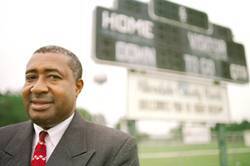| Poverty, history, and culture combined with a lack of effective teaching and classroom management conspire against Allendale County, S.C. |
Jim Taylor blows into his office, plops down in his chair, and sighs with exhaustion.Two years ago, he was the principal of one of South Carolina’s leading suburban high schools, the kind of place where most parents would wait in line to enroll their children.
This year, Taylor has come out of retirement to try to turn around the struggling high school in South Carolina’s most troubled school system--its first district to be declared in a state of emergency and taken over by the state.
Unlike many of the systems elsewhere that were so deeply mired in mismanagement and poor achievement that states have seized control, Allendale County is no urban district. It’s more than an hour’s drive from here to a town that even resembles a city. But the distance seems greater, in miles and time.
Taylor, like Superintendent John Tindal--both hired less than two months ago when low test scores prompted state Superintendent Inez Tenenbaum and Gov. Jim Hodges to step in--came here hoping to change things.
With more than 30 years’ experience as an educator, Taylor wasn’t naive. But already, he has learned that it won’t be as easy as he thought.

|
Superintendent John Tindal, 47, believes the county schools can recover. “I truly believe we might be able to beat the odds down here,” he says. |
What he and Tindal face in Allendale County are not just discipline problems, not just a lack of effective teaching and classroom management, not just abysmal test scores or inadequate leadership.
It is all of these things and more: poverty, history, and culture.
“Right now, I don’t feel like I’m accomplishing anything. I’m just putting out fires,” Taylor confesses. “The problem,” he says in a recent interview, his office door shut, “is everything.”
Many of those who are able to choose a school system have chosen against Allendale. In a county where one of every four people is white, almost all the 2,100 students in public schools are black.
Half the babies in Allendale County are born to unwed mothers, and a quarter of the population never made it past the 9th grade.
At a Glance: |
| Superintendent: John Tindal |
| Enrollment: 2,100 in four schools |
| Total Budget: $12 million |
| County Population: 11,500 |
| Racial makeup of county/district: 68 percent African-American 31 percent white 1 percent other |
| Average household income: $13,260 (S.C. average: $19,808) |
| Average price of a home: $25,122 (S.C. average: $105,164 |
Even the town of Allendale itself wears a sad face. The county courthouse, once a proud community monument, was gutted by fire several years ago and stands unrepaired. All that’s left is a hollow shell of walls and columns.
Blocks away on Main Street, a small branch of the University of South Carolina is a bright spot, but it sits amid empty storefronts and old motels, left stranded years ago by interstate detours.
Though the county’s schools had been on the slide for years, a combination of political factors set the stage for the takeover this past summer: the election of a new state schools chief last November, the power given state officials by a new accountability law, and a new governor elected on a platform that emphasized education.
In August, Tenenbaum declared a state of emergency, allowing her to run the district from her office in a high-rise office building blocks away from the copper-domed State House in Columbia. Confident in her decision, Tenenbaum headed to Allendale to break the news at a community meeting.
The state chief braced herself, knowing that in other states, takeovers had left local residents fuming over the loss of control and in many cases had resulted in lawsuits.
That didn’t happen in Allendale.
A small but vocal group of people initially opposed the takeover. “One lady called me Hitler,” recalls Tenenbaum.
But an inch-thick report from consultants hired by the state, detailing the failure of the district’s schools, was hard to argue against. The crowd at the community meeting was mostly quiet.
The study found that the school board had failed to write a five-year school improvement plan, though required to do so by law. And though the district spent $600 more each year per pupil than the South Carolina average of $5,721, test scores were at the bottom.
Allendale County had the lowest 3rd grade reading scores on the state’s basic-skills test last year. Only 53 percent of district students passed--meaning they showed minimal reading skills at their grade levels--compared with 84.4 percent statewide. Other scores were higher, but consistently among the worst in a state that itself ranks among the lowest on national tests.
Yet Allendale isn’t alone in having low test scores. What earned the district failing marks was its lack of effort to correct them.
One-quarter of Allendale’s teachers were not properly certified, and little additional training was offered, the consultants found. And despite low rankings on virtually every measure of student achievement, the district provided minimal remediation compared with other school systems.
“The community was disgusted with the state of affairs,” Tenenbaum says. “I knew the current board could not do what was necessary to move the district forward.”

|
Glimpses of Allendale County, S.C. |
Under the state takeover, the elected school board remains, but is essentially powerless. Its chairman, Charlie Cave, was one of those who pleaded in July against the takeover to the state school board. The state board unanimously rejected the appeal.
“There has been maybe some direction under previous administrators that kind of led us into the situation we’ve gotten ourselves into,” says Cave, whose feelings were hurt by the takeover. He and other board members still meet with the superintendent each month to receive updates, but they don’t vote. There’s nothing for them to vote on.
Tindal gained a reputation as a peacemaker while he was the superintendent of a small, rural district in Orangeburg County, about 40 miles from Allendale. He helped soothe the wounds left after several smaller districts in the county consolidated.
“I thought, that’s the kind of person I need,” Tenenbaum says in explaining her choice for district superintendent.
Tindal, 47, grew up in rural Lee County. He speaks plainly and has the air of someone who knows his stuff, using positive words but without ignoring the difficulties.
“Everything has not always been negative here in Allendale,” he says. “If we produced success for people in the past, there’s really hope for the future.”
Though Tindal’s challenge is immense, his mission is simple: improve test scores and student learning.
Tindal knows many eyes are on him, for many people in South Carolina believe that if Allendale can improve, then perhaps so can the whole state system.
He’ll have the help of consultants hired by the state and a yet-to-be hired assistant superintendent for instruction. Their immediate concern will be to train teachers in new academic standards and teaching methods.
But it’s the superintendent who will have to tackle one of the biggest problems here: overcoming Allendale’s racial and economic polarization and the complications that tension has brought to the management of the schools.
Restoring confidence in the public schools among whites is a delicate undertaking. And African-Americans might take offense if they think a black leader is pandering to whites who weren’t interested in the first place.
“Sometimes we don’t have support because we haven’t gone out and asked people,” says Tindal, who is African-American. “We have to work well with all people.”

|
A school bus heads by the burned-out courthouse in Allendale County, the first South Carolina school district to be taken over by the state. |
Joe Siren remembers when the schools here had that support. When he began teaching in the county 25 years ago, the economy was better. “It wasn’t exactly bustling,” he says, “but it was better.”
Until the mid-1980s, the public schools enjoyed support from the community, including a significant portion of whites and middle-class African-Americans, he says. “For a few years, we had a sparkling new building and active involvement of some of the white leaders here,” the veteran educator recalls.
“Since that time, nearly all the whites have left and a disconcerting number of middle-class blacks,” says Siren, who is white. He blames the change on the loss of some popular school administrators and opposition to the consolidation of middle schools in Allendale and Fairfax, sister towns five miles apart.
Gradually, he and others here say, many of the county’s better-off families lost faith in the schools.
After years of turmoil and decline, “there are plenty of reasons to be disenchanted,” Siren adds. “Some with young families can’t endorse this school system for their own kids.”
In an effort to change that, Tindal says he will require all his principals to work on improving parent involvement. He wants to open schools at night so people can use computers or check out books--whatever works to get them into the schools. He also hopes to revamp and expand the district’s fledgling adult education and alternative school programs.
Tindal believes that if the schools improve, support from all parts of the community will return naturally.
“I truly believe we might be able to beat the odds down here,” he says.
At Allendale-Fairfax High School, Principal Taylor’s problems offer a window into the larger challenges facing the district as a whole. this is just space.The first day of school, he realized there wasn’t even an efficient system to distribute textbooks. What should have taken a few hours, he says, took days.
Discipline occupies much of Taylor’s time. He says he’s lost count of how many students have been suspended and expelled in only the first six weeks of school.

|
Senior Chris Rhodes, above, with his aunt, Beverly Rhodes, says much of the criticism of the schools is unfair. “There are some situations schools can’t change, he says. “It goes into the whole aspect of Allendale County.” |
“I had a student tell me that ‘you all don’t run the school. We run the school,’ ” says the white-haired administrator. He’s here under a new state law that allows retired teachers and administrators to be rehired without losing retirement money.
Though the tan-brick high school looks fairly modern from the outside, the inside of the county’s only high school needs work: The paint is hardly fresh, the carpet badly worn, and safety systems questionable. “Our fire alarm system, when I got here, wasn’t working,” Taylor says.
With custodians busy cleaning, no full-time maintenance person is available to make repairs, Taylor says. The principal and his son recently spent a day outside pruning shrubs and trimming weeds, and he waited days for custodians to hang a bright yellow banner in the lobby, which he wanted put up before a visit from one of Tenenbaum’s aides.
Many classrooms lack even the most basic tools, notably dictionaries. A local business recently committed $1,000 to change that. And Taylor’s old school, in suburban Columbia, agreed to donate a photocopier after the principal drove two hours to have copies printed of the agenda for a faculty meeting.
It’s those things, Taylor says, that steal his time away from the bigger issues. “My problem is, I’m only a short-timer,” he says. “I have this raging impatience.”
One of those bigger issues is teacher quality, but Taylor worries that a large chunk of the staff won’t be around for extra training. Nearly half the school’s teachers leave each year for jobs in less remote places.
“I want them to stay,” he says. But, he adds, “Allendale doesn’t have much to offer. It’s 45 or 50 miles to the nearest movie theater.”
If academic engagement lives at Allendale-Fairfax High, it’s in the debate team’s workroom. Shelves circle the room, sagging under the weight of hundreds of trophies and plaques won by students against some of the better schools in the state and even the nation.
Sophomore Courtney Smith thumbs through a file folder, conducting research for a weekend competition at a school in Charleston. The topic for all the debates this season is, ironically, student achievement.
In her hands are statistics showing that Allendale students have an average combined SAT score of 766 out of 1600. The same list shows Taylor’s old district in suburban Columbia with an average of 1049.
Another page contains Advanced Placement statistics. More than half the 9,402 students in South Carolina who took AP exams last year passed them.

|
Interstate detours and economic decline have taken their toll. |
Not a soul in Allendale County passed.
None of this surprises Smith, who says she one day wants to attend Duke University and become a lawyer. Her father teaches at a community college in New York City, her grandmother teaches at Allendale-Fairfax Middle School, and her mother works at the nearby state prison.
Though Smith has found a place on the debate team, she says there’s not much more for college-bound students at Allendale-Fairfax to choose from.
If only, she says, “we could have more teachers like Mr. Siren. He may refer to something in the book, but he’s so smart from experience he can relate it to you.”
Siren, a witty, gray-bearded social studies teacher, coaches the debate team. He says that by taking the team to competitions, like one last year at Harvard University, he hopes to show them things they’ve never seen before, both in the world and within themselves.
Colorful pennants on his classroom walls boast of the colleges his students have attended, including Yale University, Princeton University, Duke, Boston College, the Georgia Institute of Technology, and the U.S. Air Force Academy.
| Sophomore Courtney Smith says that with the revolving door of teachers at the school, it’s sometimes hard to find inspiration. |
Smith says that with the revolving door of teachers at the school, it’s sometimes hard to find the inspiration she finds in Siren’s classes and on the debate team.
“It’s not much of a challenge,” she says, describing most of her classes.
But one of her schoolmates, senior Chris Rhodes, says the school gets a bad rap. A standout student with a combined SAT score of 1480, he hopes to attend Stanford University or an Ivy League school.
Rhodes says that it’s too simple to blame the problems here on the quality of the school and its educators, and that the larger picture of the economic and social life of the community plays a part.
“If you just live around Allendale and this is all you see, some people just get the impression this is all there is for them,” he says. “There are some situations schools can’t change. It goes into the whole aspect of Allendale County.”
At a meeting of department heads at the high school, Eddie West takes the floor. A former superintendent in several North Carolina districts, his firm conducted the study recommending the Allendale takeover.

|
Veteran teacher Joe Siren coaches Allendale-Fairfax High School’s award-winning debate team, one of the few academic bright spots in a district with some of the worse test scores in the state. |
West hands out sheets of paper describing South Carolina’s new state academic standards, which students will be tested on this year.
The results of those tests will be used to prepare South Carolina’s first-ever school report cards, and can ultimately determine whether school administrators keep their jobs.
The group sits quietly. This is the start of something new for many of their classes.
“Students must be presented learning opportunities where they’ve got to do these things,” West explains.
The lists on West’s handouts show critical-thinking standards that the state believes every student should be taught at various levels: Select major points from written research, set priorities for pertinent information, present information in a speech, and so on.
West says teachers will learn in training sessions how to teach the standards and how to improve their instruction.
As he finishes, Taylor speaks up, his voice stern. “We’ve made excuses forever,” the principal tells the group. “About next spring and summer, whether or not we win a football game or a basketball game or a tennis match is not going to matter when those scores come out. This is the year we’ve got to produce.”
Just down the highway from the high school, it’s an important day at Allendale Primary School. The fountain is flowing in the lobby, and cookies and soft drinks are ready for a reception in the library.
The governor is coming. Hodges, a Democrat elected last November on an education-and-lottery platform, depended heavily on African-American voters in places such as Allendale to win.
His quick visit is designed as an endorsement of the state role here, a sign that the takeover is being taken seriously at the top.
After reading to preschoolers in one building at the 600-student school, the governor, flanked by about 25 onlookers, security officers, and aides, stepped outside, walking to adjoining flat-roofed buildings that form the school’s campus.
Hodges says the takeover has drawn the interest of business and political leaders across the state. “They realize it’s an economic issue for us,” he says.
After he leaves, Evelyn Smith and other administrators and teachers gather in the library. They eat the cookies that were meant for the governor.
Smith, the principal of the pre-K-4 school for three years now, was initially not a big fan of the takeover.
“We were all somewhat skeptical in the beginning,” she says. “We didn’t know what to expect. After we’ve been into it for a while, I think we all feel better.”
If the Allendale County experiment proves its worth, the district may not be the last in South Carolina to be declared in a state of emergency. ignore this space.Other districts that fit Allendale’s profile of poor, remote, and racially segregated are on the state’s list of impaired schools. If they fail to show progress, they could be next.
As for Allendale, Tenenbaum acknowledges that the takeover won’t be a quick fix. She says it may last indefinitely, although her stated goal is to return power to the local school board.
“It certainly won’t be in the next two years,” the state superintendent says. “The issues are so deep and systemic ... it’s going to take several years to see results. There’s so much work to be done.”
Jim Taylor couldn’t agree more. By week’s end, the weary principal finally saw his yellow banner hung in the school lobby. Its hopeful message offered a reminder of what the state hopes to accomplish here: “Allendale-Fairfax High School, Excellence in the Making.”




